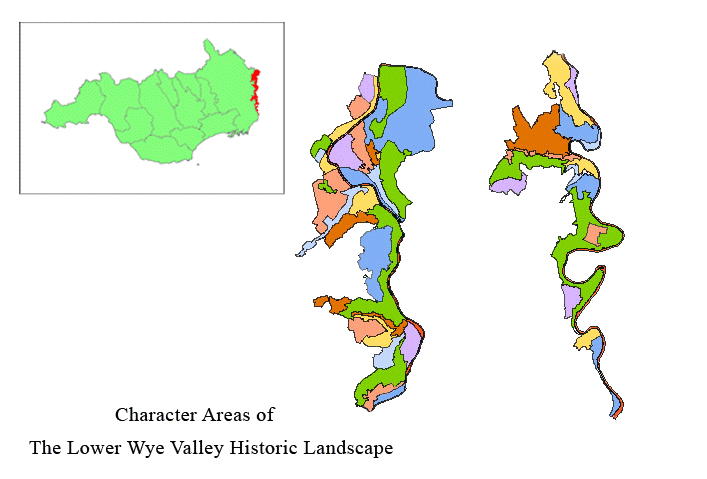Historic Landscape Characterisation
Lower Wye Valley
The area selected here as the Lower Wye Valley extends between Symonds Yat, Monmouth and Chepstow, where for the greater distance it takes the form of a long, narrow gorge incised through the Lower Wye-Forest of Dean limestone plateau situated at the southern end of the valley of the River Wye. The sharply meandering gorge is characterised in several places by sheer limestone cliffs and very steep slopes which rise 150 to 200m from the valley floor, which is at just above sea level, to the plateau surfaces on either side. Between the gorges, the valley has broader reaches with more rounded hills and bluffs, often overlooking smaller tributary valleys.
Use the map to select your area of interest or go directly to character area summaries.
The area is acknowledged to be one of the most scenically attractive lowland landscapes in Britain, and one of the few lowland Areas of Outstanding Natural Beauty. It is also one of the few remaining areas with comparatively large tracts of ancient broadleaved woodlands, whilst the pastures, hay meadows, hedges and copses of the farmed landscape in and around the valley are also rich natural habitats with historical significance.
In the history of art, the scenic qualities of the valley were early appreciated and inspired the Reverend William Gilpin in 1770 to write his important treatise on the notion and depiction of landscape as the Picturesque. Along with its artistic associations, the valley also has a rich archaeological legacy, from the prehistoric to the recent past, reflecting its importance as a communication route, a natural and political boundary, and a centre of religious life and of several early industries.
The archaeological sites range from Bronze Age round barrows and Iron Age hillforts, such as Blackfield Wood camp, which provide spectacular vantage points over the valley, to Romano-British sites and Norman earthwork castles. Closely following the course of the River Wye, high above its eastern flank, is Offa's Dyke, the 8th century linear earthwork which was of enormous economic and political significance. As an impressive and well-preserved, man-made earthwork, the Dyke now forms an integral part of the natural, as well as the historic environment. Each end of the gorge is dominated by the medieval castle boroughs of Monmouth and Chepstow, key strategic points in the conquest of Wales in the late 11th century, and prior to this probably important settlements in the Roman and Dark Age periods. Today the river still forms sections of the national boundary between England and Wales.
In addition to being a frontier, the River Wye has contributed to the economic growth of the valley, providing a means of transport, trade and communication. Most goods were transported to and from Monmouth by means of barges until 1815 when roads were made through the district. The importance of the Wye in this respect is indicated by surviving names such as The Sloop Inn at Llandogo. However, free passage up and down the river was hindered by the weirs constructed to catch salmon. These weirs often became the source of contention, well-documented since the 14th century.
The central part of the valley is physically and spiritually dominated by the spectacular remains of Tintern Abbey, one of the most celebrated monastic sites in the British Isles founded in 1131, its ruins still towering over the valley floor in its tranquil setting. The complex of monastic features and buildings extending to some 11ha, including the Abbey church, was remodelled and expanded several times in its four centuries of existence, reflecting the disposal of great wealth. This large Cistercian House is visually enhanced in its present landscape through surviving historic and cherished views, by 18th century and later artists.
The valley has a rich industrial heritage which has influenced the settlement pattern greatly. Archaeological evidence confirms the commercial exploitation of the woodlands in the Wye valley and the neighbouring Forest of Dean. This area with its ready supply of wood for charcoal formed one of the most extensive concentration of iron smelting sites in Britain, from the Roman period up to the late 18th century. In addition, papermaking, tanning, tin-plate manufacture, stone quarrying and millstone making were other industrial activities in the valley and its tributaries. They contributed to the establishment and growth of many of the villages, which became reliant on the river as an artery for trade and communication.
Tintern Abbey was one of the major factors in the founding of the settlement of Tintern, which, after the Dissolution of the monasteries in the 16th century, was largely devoted to industries making use of waterpower and abundant timber. Continuity of these industries, dependent on water management, can be seen in the tributary valleys of the Angidy, Whitebrook, and the Lower and Upper Redbrook.
Successional remains of early industry dependent on water management are also preserved in the valley of the Whitebrook which rises at Five Trees and flows east through a wooded valley to meet the Wye, 6km south of Monmouth. The first industry attracted to this tributary of the Wye was wireworking, built as an extension to the famous Tintern Wire Works about 1567. By 1600, there were probably five wireworks sites operating in the valley. Paper milling became established about 176I, when wallpaper became a popular means of decorating the interiors of fashionable homes. The remains of four paper mills survive along the length of the valley and these, with their ancillary archaeological features, such as embanked ponds and leats, represent an important example of early industrial settlement, the character of which has not been marred by modern development. On the east side of the Wye valley, some 4km south east of Monmouth, there were several corn mills in the Upper Redbrook valley and a tin-plate works in the adjacent Lower Redbrook valley. Of architectural interest, the Upper Redbrook valley contains the Redbrook Incline overbridge and Swanpool Railway bridge with its curious looking, skewed brick tunnel construction.
